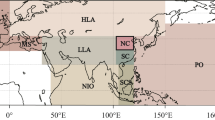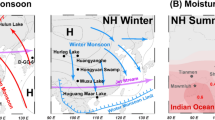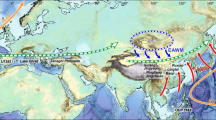Abstract
The El Niño/Southern Oscillation (ENSO) phenomenon is believed to have operated continuously over the last glacial–interglacial cycle1. ENSO variability has been suggested to be linked to millennial-scale oscillations in North Atlantic climate during that time2,3, but the proposals disagree on whether increased frequency of El Niño events, the warm phase of ENSO, was linked to North Atlantic warm or cold periods. Here we present a high-resolution record of surface moisture, based on the degree of peat humification and the ratio of sedges to grass, from northern Queensland, Australia, covering the past 45,000 yr. We observe millennial-scale dry periods, indicating periods of frequent El Niño events (summer precipitation declines in El Niño years in northeastern Australia). We find that these dry periods are correlated to the Dansgaard–Oeschger events—millennial-scale warm events in the North Atlantic climate record—although no direct atmospheric connection from the North Atlantic to our site can be invoked. Additionally, we find climatic cycles at a semiprecessional timescale (∼11,900 yr). We suggest that climate variations in the tropical Pacific Ocean on millennial as well as orbital timescales, which determined precipitation in northeastern Australia, also exerted an influence on North Atlantic climate through atmospheric and oceanic teleconnections.
This is a preview of subscription content, access via your institution
Access options
Subscribe to this journal
Receive 51 print issues and online access
$199.00 per year
only $3.90 per issue
Buy this article
- Purchase on Springer Link
- Instant access to full article PDF
Prices may be subject to local taxes which are calculated during checkout




Similar content being viewed by others
References
Tudhope, A. W. et al. Variability in the El Niño-Southern Oscillation through a glacial-interglacial cycle. Science 291, 1511–1517 (2001)
Broecker, W. S. Does the trigger for abrupt climate change reside in the ocean or in the atmosphere? Science 300, 1519–1522 (2003)
Stott, L., Poulsen, C., Lund, S. & Thunell, R. Super ENSO and global climate oscillations at millennial time scales. Science 297, 222–226 (2002)
Bond, G. et al. Correlations between climate records from north Atlantic sediments and Greenland ice. Nature 365, 143–147 (1993)
Grousset, F. E. et al. Patterns of ice-rafted detritus in the glacial North Atlantic (40–55°N). Paleoceanography 8, 175–192 (1993)
Gagan, M. K. et al. New views of tropical paleoclimates from corals. Quat. Sci. Rev. 19, 45–64 (2000)
Hendy, I. L. & Kennett, J. P. Tropical forcing of North Pacific intermediate water distribution during Late Quaternary rapid climate change? Quat. Sci. Rev. 22, 673–689 (2003)
Spero, H. J., Mielke, K. M., Kalve, E. M., Lea, D. W. & Pak, D. K. Multispecies approach to reconstructing eastern equatorial Pacific thermocline hydrography during the past 360 kyr. Paleoceanography 18, 1–16 (2003)
Wang, Y. J. et al. A high-resolution absolute-dated late Pleistocene monsoon record from Hulu Cave, China. Science 294, 2345–2348 (2001)
Hoerling, M. & Kumar, A. The perfect ocean for drought. Science 299, 691–694 (2003)
Clement, A. C., Cane, M. A. & Seager, R. An orbitally driven tropical source for abrupt climate change. J. Clim. 14, 2369–2375 (2001)
Kershaw, A. P. Record of last interglacial-glacial cycle from northeastern Queensland. Nature 72, 159–161 (1978)
McGlone, M. S., Kershaw, A. P. & Markgraf, V. in El Niño: Historical and Paleoclimatic Aspects of the Southern Oscillation (eds Diaz, H. F. & Markgraf, V.) 435–462 (Cambridge Univ. Press, Cambridge, 1992)
Godfred-Spenning, C. R. & Reason, C. J. C. Interannual variability of lower-tropospheric moisture transport during the Australian Monsoon. Int. J. Clim. 22, 509–532 (2002)
Dai, A. & Wigley, T. M. L. Global patterns of ENSO-induced precipitation. Geophys. Res. Lett. 27, 1283–1286 (2000)
Rognon, P. & Williams, M. A. J. Late Quaternary climatic changes in Australia and North Africa: A preliminary interpretation. Palaeogeogr. Palaeoclimatol. Palaeoecol. 21, 285–327 (1977)
Nanson, G. C., Price, D. M. & Short, S. A. Wetting and drying of Australia over the past 300 ka. Geology 20, 791–794 (1992)
Johnson, B. J. et al. 65,000 years of vegetation change in central Australia and the Australian summer monsoon. Science 284, 1150–1152 (1999)
Turney, C. S. M. et al. Redating the onset of burning at Lynch's crater (North Queensland): Implications for human settlement in Australia. J. Quat. Sci. 16, 767–771 (2001)
Blackford, J. J. & Chambers, F. M. Determining the degree of peat decomposition for peat based palaeoclimatic studies. Int. Peat J. 5, 7–24 (1993)
Voelker, A. H. L., Grootes, P. M., Nadeau, M.-J. & Sarnthein, M. Radiocarbon levels in the Iceland Sea from 25–53 kyr and their link to the Earth's magnetic field intensity. Radiocarbon 42, 437–452 (2000)
Stuiver, M. & Grootes, P. M. GISP2 oxygen isotope ratios. Quat. Res. 53, 277–284 (2000)
Laj, C. et al. Geomagnetic field intensity, North Atlantic Deep Water circulation and atmospheric Δ14C during the last 50 kyr. Earth Planet. Sci. Lett. 200, 177–190 (2002)
Jenkins, G. M. & Watts, D. G. Spectral Analysis and its Applications (Holden Day, Oakland, 1968)
Moy, C. M., Seltzer, G. O., Rodbell, D. T. & Anderson, D. M. Variability of El Niño/Southern Oscillation activity at millennial timescales during the Holocene epoch. Nature 420, 162–165 (2002)
Wang, H., Follmer, L. R. & Liu, J. C. Isotope evidence of paleo-El Niño-Southern Oscillation cycles in loess-paleosol record in the central United States. Geology 28, 771–774 (2000)
Schulz, M. The tempo of climate change during Dansgaard-Oeschger interstadials and its potential to affect the manifestation of the 1470-year climate cycle. Geophys. Res. Lett. 29, doi:2001GL013277 (2002)
Kukla, G. J., Clement, A. C., Cane, M. A., Gavin, J. E. & Zebiak, S. E. Last interglacial and early glacial ENSO. Quat. Res. 58, 27–31 (2002)
Rind, D. Latitudinal temperature gradients and climate change. J. Geophys. Res. 103, 5943–5971 (1998)
MacAyeal, D. R. Binge/purge oscillations of the Laurentide Ice Sheet as a cause of the North Atlantic's Heinrich Events. Eos 74, 359 (1993)
Acknowledgements
We thank M. Gagan and B. Opdyke for suggestions about earlier drafts of this manuscript. C.S.M.T. acknowledges fellowships from the Australian Research Council and the Menzies Institute (King's College, London) held at the Australian National University. We thank S. Haberle and J. Luly for assistance in the field, G. Anderson and A. Crawford for permission to core Lynch's crater and E. Turton for laboratory preparations. This work was supported by The National Geographic, the ARC, Monash University, The Royal Society, ANSTO and NERC.
Author information
Authors and Affiliations
Corresponding author
Ethics declarations
Competing interests
The authors declare that they have no competing financial interests.
Supplementary information
Supplementary Figure
Cross-spectral analysis of the Lynch’s Crater Cyperaceae/Poaceae and GISP2 δ18O records for the last 50 ka using the Blackman-Tukey approach. (JPG 40 kb)
Rights and permissions
About this article
Cite this article
Turney, C., Kershaw, A., Clemens, S. et al. Millennial and orbital variations of El Niño/Southern Oscillation and high-latitude climate in the last glacial period. Nature 428, 306–310 (2004). https://doi.org/10.1038/nature02386
Received:
Accepted:
Issue Date:
DOI: https://doi.org/10.1038/nature02386
This article is cited by
-
A Jurassic record encodes an analogous Dansgaard–Oeschger climate periodicity
Scientific Reports (2022)
-
Diatom-inferred centennial-millennial postglacial climate change in the Pacific Northwest of North America
Journal of Paleolimnology (2022)
-
Direct astronomical influence on abrupt climate variability
Nature Geoscience (2021)
-
Tropical teleconnection impacts on Antarctic climate changes
Nature Reviews Earth & Environment (2021)
-
Southern Hemisphere climate variability forced by Northern Hemisphere ice-sheet topography
Nature (2018)
Comments
By submitting a comment you agree to abide by our Terms and Community Guidelines. If you find something abusive or that does not comply with our terms or guidelines please flag it as inappropriate.



